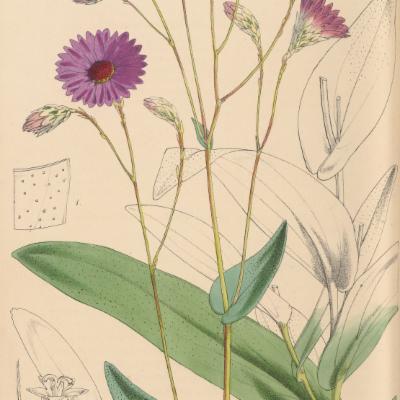Geography and distribution
Native to south-western Australia.
Description
Overview: A hardy, hairless annual, growing to about 0.5 m tall, with smooth, rounded, branching stems with a leaf at the point of branching. The branches are wavy and slender and the flowerheads are borne singly.
Leaves: The leaves are oblong-obtuse, heart-shaped and embrace the stem at the base. They are dark green above and paler beneath.
Flowers: The flowerheads (capitula) appear mainly in the spring and summer and have a central disc consisting of numerous yellow, tubular disc florets, surrounded by a concave ring of rose-coloured or white, papery bracts (phyllaries), beneath which are layers of overlapping, purplish-grey, papery scales.
Fruits: Each cypsela (fruit) is shed with its pappus, which has feathery hairs. These act like a tiny parachute and help in fruit dispersal.
Uses
Everlastings are popular in cultivation for their colourful display, particularly when grown in massed plantings. They are a well known symbol of Australia and attract large numbers of tourists when in flower. The flowerheads can be dried, and will keep their shape and colour.
Millennium Seed Bank: Seed storage
Kew's Millennium Seed Bank Partnership aims to save plant life world wide, focusing on plants under threat and those of most use in the future. Seeds are dried, packaged and stored at a sub-zero temperature in our seed bank vault.
Search Kew's Seed Information Database for further infomation on Rhodanthe manglesii seeds
Cultivation
Mangles' everlasting can be grown in most temperate areas and performs best in well-drained soil in a sunny position. It can be propagated by seed, sown in late autumn or early winter, or can be grown from cuttings.
This species at Kew
Rhodanthe manglesii is not currently grown at Kew. Pressed and dried specimens are held in Kew's Herbarium, where they are available to researchers by appointment.
Preserved specimens of Mangles' everlasting flowers are held in Kew's Economic Botany Collection (under the synonym Helipterum manglesii ) in the Sir Joseph Banks Building and are available to researchers by appointment.
Australia Landscape - Kew at the British Museum
In 2011, Kew and the British Museum brought to the heart of London a landscape showcasing the rich biodiversity of Australia, and how these fragile systems are under threat from land usage and climate change.
Rhodanthe manglesii (Mangles' everlasting) was one of 12 star plants featured in the Landscape, which took you on a journey across a whole continent, from eastern Australia's coastal habitat, through the arid red centre, to the western Australian granite outcrop featuring unique and highly endangered plants.
Australia Landscape was part of the Australian season at the British Museum. Supported by Rio Tinto .



